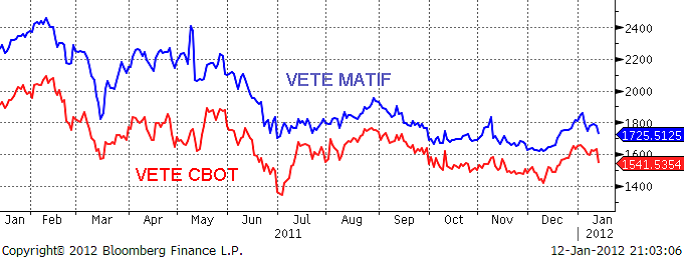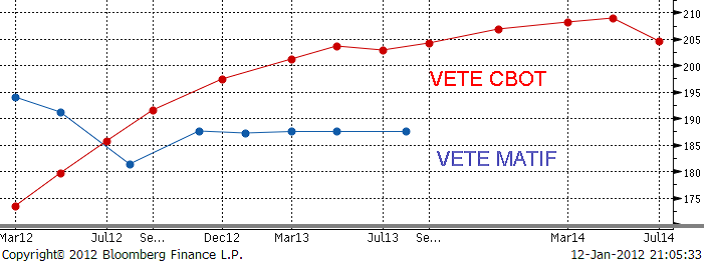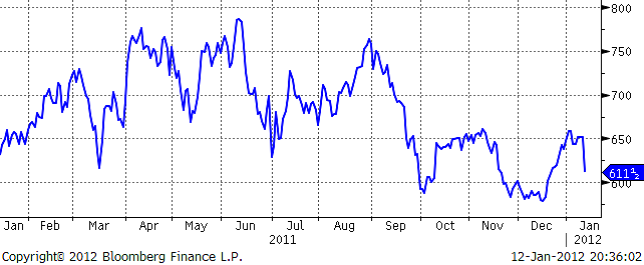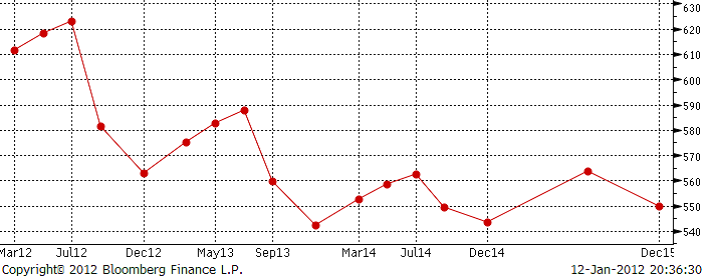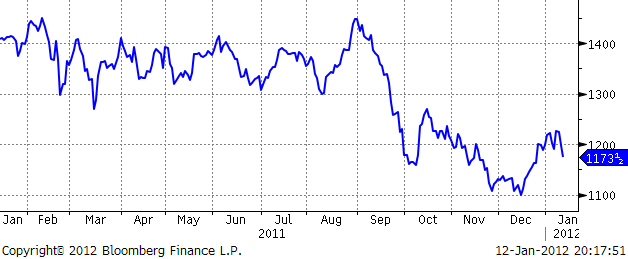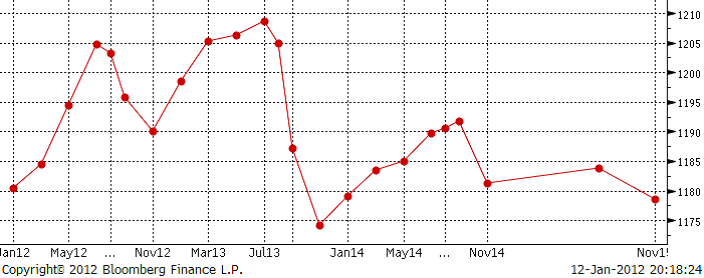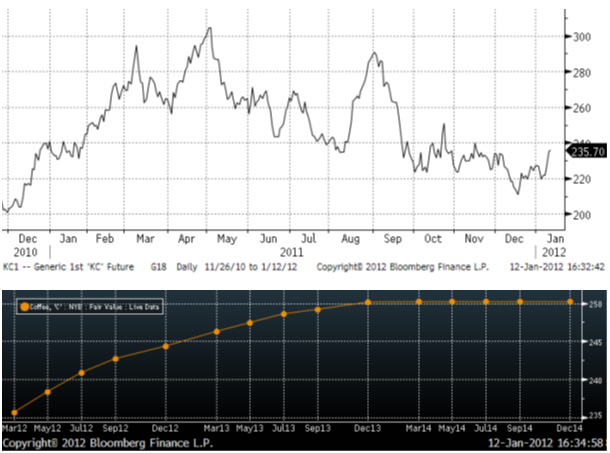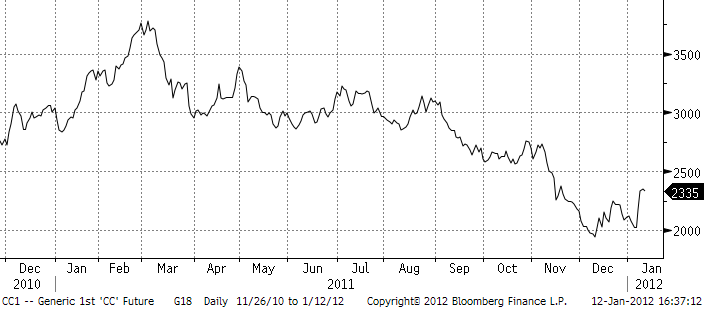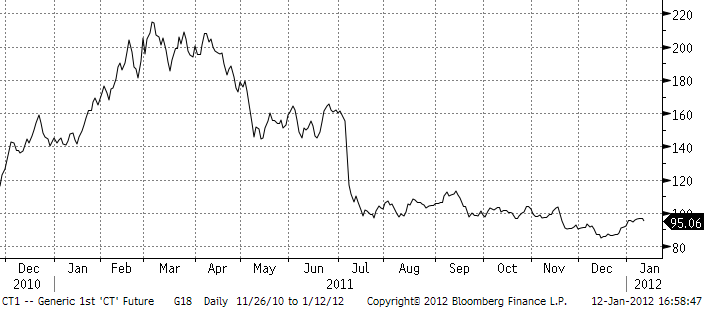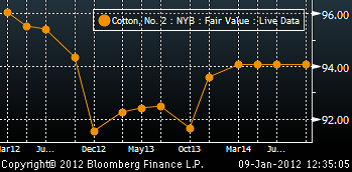Analys
SHB Råvarubrevet 13 januari 2012
 Vetepriset på Matif stängde igår på en något högre nivå jämfört med förra torsdagen, trots gårdagens kraftiga fall orsakat av januari månads rapport från USDA – se nästa sida. Fallet blev klart större i USA och vetet i Chicago noteras ned sedan förra veckan. En fortsatt försvagning av euron i förhållande till den amerikanska dollarn har påverkat det europeiska vetets relativt bättre utveckling den senaste tiden.
Vetepriset på Matif stängde igår på en något högre nivå jämfört med förra torsdagen, trots gårdagens kraftiga fall orsakat av januari månads rapport från USDA – se nästa sida. Fallet blev klart större i USA och vetet i Chicago noteras ned sedan förra veckan. En fortsatt försvagning av euron i förhållande till den amerikanska dollarn har påverkat det europeiska vetets relativt bättre utveckling den senaste tiden.
amerikanska vetearealen justerades upp mer än väntat i gårdagens rapport, annars har vetet fortsatt att följa prisutvecklingen för majs och därmed väderutvecklingen i Sydamerika i väldigt hög grad under de senaste veckorna. Efter gårdagens rapport kommer fokus återigen riktas på väderutvecklingen i Sydamerika, vilken är svår att förutse.
Den australiensiska veteskörden är i stort sett klar, trots mycket regn uppges kvaliteten kunna bli något bättre än tidigare befarat. Den argentinska veteskörden är även den i stort sett klar, små regnskurar fördröjde skördearbetet något på slutet men utan större problem. För vetet i EU finns inga större skäl till oro, även om mer snö är önskvärt. Oron är dock större för vetet i Ukraina, som fortfarande även det har för lite snö, men vintern har hittills varit väldigt mild mot det ukrainska vetet med låga temperaturer. Hela 35 procent av höstvetet i Ukraina uppges dock vara i dåligt skick vilket kommer påverka framtida exportvolymer.
Vart vetepriserna är på väg är väldigt osäkert inte minst innan vintern är över och vi får en klar bild över grödornas skick, inte bara i Ukraina utan även i USA där höstvetet är i dåligt skick har dock vintern varit mild. Utan fortsatt torrt och varmt väder i Sydamerika, med stigande majs- och sojapriser som följd, är det i nuläget svårt att se högre vetepriser den närmaste tiden.
Majs
Terminspriserna på majs i Chicago har backat kraftigt sedan förra veckan, en nedgång som orsakades av gårdagens rapport från USDA i vilken siffrorna för utgående lager av majs i USA var klart högre än väntat – se nästa sida. Även utgående globala lager av majs justerades upp.
Efterfrågan på amerikansk majs har varit låg den senaste tiden, oro för minskande efterfrågan från etanolindustrin ger även det press nedåt. Uppgången veckorna innan gårdagens fall har i stort sett helt påverkats av torkan i Sydamerika, främst Argentina. Det har fallit en del regn men ej i tillräcklig mängd och dessutom något för sent i flera områden. Kommande prisutveckling lär under några veckor vara starkt beroende av den fortsatta väderutvecklingen i Argentina och Brasilien, vilken är väldigt svår att förutse.
USDA uppskattar den kommande argentinska majsskörden till 26 miljoner ton, de flesta sydamerikanska analytiker förväntar sig dock en skörd kring 23-25 miljoner ton – alltså klart lägre och risk finns att USDA underskattar torkans effekt. En hel del av detta bortfall bör dock kunna kompenseras av fodervete från andra delar av världen, vilket det finns gott om.
Lite längre fram kommer snart fokus riktas mot kommande sådd i USA, arealen spås av många bli den största någonsin som följd av höga priser – men konkurrens om arealen lär komma från sojabönor.
Sojabönor
Terminspriserna på sojabönor har backat något sedan förra veckan, delvis som följd av viss nederbörd i torkdrabbade Sydamerika men framförallt följde sojabönorna med majsen ned efter USDA-rapporten igår – se nästa sida. Till våren vid tid för sådd i USA kommer de båda grödorna slåss om areal vilket gör att det finns en relativt stark koppling mellan grödornas pris. Under gårdagen backade dock priset på sojabönor klart mindre än majsen med omkring 2 procent jämfört med majsens fall på ungefär 6 procent.
Vädret i Sydamerika har varit under stort fokus under flera veckor nu och lär vara så i flera veckor till. USDA:s nedjustering av den argentinska sojaproduktionen blev klart mindre än många väntat med blygsamma 1,5 miljoner ton – flera sydamerikanska analytiker uppskattar att torkan hittills skapat en skördeförlust på uppemot 6 miljoner ton. Förvånande är kanske också USDA:s nedjustering på 1 miljon ton av den brasilianska skörden, flera analytiker hävdar att en nedjustering med omkring 5 miljoner ton vore mer korrekt. I den näst största sojaproducerande delstaten i Brasilien, Parana, bedöms endast 57 procent av grödan vara i bra skick, att jämföra med 95 procent en månad tidigare.
Den kritiska perioden för sojabönor i Argentina ligger några veckor fram i tiden, men i Brasilien har alltså en ganska kraftig skada redan skett – vilket kanske i alla fall USDA inte riktigt tagit på allvar. Det har fallit en del regn den senaste tiden, men de brasilianska lantbrukarna har lärt sig att inte ta ut segern i förskott – det regnar alltid något, även under riktigt torra år.
Kommande prisutveckling är under en ganska lång tid främst beroende av väderutvecklingen i Sydamerika, vilken är väldigt svårbedömd.
Kaffe
Under 2011 rörde sig kaffepriset mellan ett intervall av 210,95 – 304,90 USd/Ib och ser man till prisutvecklingen från årets början så har kaffe rört sig ned 3-4 procent och stängde innan årets slut på 226,85 USd/Ib.
Hittills har avkastningen från Centralamerika varit en besvikelse, trots att den Mexikanska produktionen visat sig vara stark. Lägre produktion väntas från Colombia om regnet fortsätter. De extrema väderförhållandena som råder i de kaffeproducerande områdena just nu kan komma att påverka kaffeproduktionen för det kommande året.
Det spekuleras om att Brasilien, världens största kaffeproducent, inte kommer att kunna möta den inhemska efterfrågan och den förväntade exporten trots rekordskörd i år. Detta har fått kaffepriset att studsa upp de senaste veckorna. 90 procent av den vietnamesiska skörden har skördats hittills men endast 20-25 procent av bönorna har sålts. Normalt för perioden är att hälften av bönorna ska ha släpps ut på marknaden. Orsaken till detta är att de vietnamesiska bönorna håller tillbaka försäljningen för att pressa upp priserna ytterligare.
Kakao
Kakaopriset rörde sig mellan ett intervall av $3774 -1936/ton under 2011. Kakaopriset stängde på $2109/ton vid årets slut, en nedgång med ca 40 procent sedan årets början. Goda väderförhållanden, globalt överskott och lägre konsumtion av kakao samt det svaga ekonomiska läget i världen har lett till att kakao tillhört de råvaror med sämst prisutveckling under förra året.
Under veckan har vi kunnat ta del av rapporter om strejk i Nigeria, världens fjärde största kakaoproducent. Marknaden är orolig för produktionsstörningar i området. Torrt väder kring Elfenbenskusten under de senaste veckorna och signaler om en ökad efterfrågan från Europa har varit några av orsakerna som drivit upp kakaopriset kraftigt.
Kakao terminskurva
Bomull
2011 rörde sig bomullspriset mellan ett intervall av 85,12 – 215,15 USd/Ib. Priset har fallit med drygt 55 procent sedan årshögsta och stängde vid årets slut på 91,80 USd/Ib.
Världskonsumtionen av bomull förväntas falla med 2,5 procent från förra säsongen som en följd av den tröga globala ekonomin medan den globala bomullsproduktionen väntas stiga 7 procent till rekordhöga 123,4 miljoner bales (1 bale = 218 kg), enligt USDA’s rapport för 2011/2012 som släpptes 12 december. Australiens produktion väntas stiga 19 procent, medan Brasiliens produktion väntas vara oförändrad. Kina, världens ledande bomullsproducent, väntas odla 10 procent mer bomull jämfört med förra året. Indien och Pakistan väntas öka sin produktion med 8 respektive 14 procent. Den amerikanska skörden 2011/2012 väntas sjunka med 13 procent jämfört med förra året. Den globala exporten för 2011/2012 väntas stiga 3 procent från förra året, i huvudsak p.g.a. den förväntade stigande produktionen. Kinas import, världens största importör av bomull, väntas stiga med hela 29 procent från tidigare år, detta som en följd av att Kina har importerat markant den senaste tiden för att nå sina mål av lagernivå, annars väntas importen hos flera importerade länder att falla.
Sedan årsskiftet har bomullspriset dock stigit något baserat på spekulationer om ökad efterfrågan som en följd av ett lugnare ekonomiskt läge. En annan faktor som varit orsaken till prisrallyt är det torra vädret i Sydamerika och i Texas. Annars har fonder ombalanserat sina portföljer och utökat sina bomullsinnehav. Marknaden oroar sig över ett andra år av minskad efterfrågan om det globala ekonomiska situationen förvärras.
[box]SHB Råvarubrevet är producerat av Handelsbanken och publiceras i samarbete och med tillstånd på Råvarumarknaden.se[/box]
Ansvarsbegränsning
Detta material är producerat av Svenska Handelsbanken AB (publ) i fortsättningen kallad Handelsbanken. De som arbetar med innehållet är inte analytiker och materialet är inte oberoende investeringsanalys. Innehållet är uteslutande avsett för kunder i Sverige. Syftet är att ge en allmän information till Handelsbankens kunder och utgör inte ett personligt investeringsråd eller en personlig rekommendation. Informationen ska inte ensamt utgöra underlag för investeringsbeslut. Kunder bör inhämta råd från sina rådgivare och basera sina investeringsbeslut utifrån egen erfarenhet.
Informationen i materialet kan ändras och också avvika från de åsikter som uttrycks i oberoende investeringsanalyser från Handelsbanken. Informationen grundar sig på allmänt tillgänglig information och är hämtad från källor som bedöms som tillförlitliga, men riktigheten kan inte garanteras och informationen kan vara ofullständig eller nedkortad. Ingen del av förslaget får reproduceras eller distribueras till någon annan person utan att Handelsbanken dessförinnan lämnat sitt skriftliga medgivande. Handelsbanken ansvarar inte för att materialet används på ett sätt som strider mot förbudet mot vidarebefordran eller offentliggörs i strid med bankens regler.
Analys
Brent crude ticks higher on tension, but market structure stays soft

Brent crude has climbed roughly USD 1.5-2 per barrel since Friday, yet falling USD 0.3 per barrel this mornig and currently trading near USD 67.25/bbl after yesterday’s climb. While the rally reflects short-term geopolitical tension, price action has been choppy, and crude remains locked in a broader range – caught between supply-side pressure and spot resilience.

Prices have been supported by renewed Ukrainian drone strikes targeting Russian infrastructure. Over the weekend, falling debris triggered a fire at the 20mtpa Kirishi refinery, following last week’s attack on the key Primorsk terminal.
Argus estimates that these attacks have halted ish 300 kbl/d of Russian refining capacity in August and September. While the market impact is limited for now, the action signals Kyiv’s growing willingness to disrupt oil flows – supporting a soft geopolitical floor under prices.
The political environment is shifting: the EU is reportedly considering sanctions on Indian and Chinese firms facilitating Russian crude flows, while the U.S. has so far held back – despite Bessent warning that any action from Washington depends on broader European participation. Senator Graham has also publicly criticized NATO members like Slovakia and Hungary for continuing Russian oil imports.
It’s worth noting that China and India remain the two largest buyers of Russian barrels since the invasion of Ukraine. While New Delhi has been hit with 50% secondary tariffs, Beijing has been spared so far.
Still, the broader supply/demand balance leans bearish. Futures markets reflect this: Brent’s prompt spread (gauge of near-term tightness) has narrowed to the current USD 0.42/bl, down from USD 0.96/bl two months ago, pointing to weakening backwardation.
This aligns with expectations for a record surplus in 2026, largely driven by the faster-than-anticipated return of OPEC+ barrels to market. OPEC+ is gathering in Vienna this week to begin revising member production capacity estimates – setting the stage for new output baselines from 2027. The group aims to agree on how to define “maximum sustainable capacity,” with a proposal expected by year-end.
While the IEA pegs OPEC+ capacity at 47.9 million barrels per day, actual output in August was only 42.4 million barrels per day. Disagreements over data and quota fairness (especially from Iraq and Nigeria) have already delayed this process. Angola even quit the group last year after being assigned a lower target than expected. It also remains unclear whether Russia and Iraq can regain earlier output levels due to infrastructure constraints.
Also, macro remains another key driver this week. A 25bp Fed rate cut is widely expected tomorrow (Wednesday), and commodities in general could benefit a potential cut.
Summing up: Brent crude continues to drift sideways, finding near-term support from geopolitics and refining strength. But with surplus building and market structure softening, the upside may remain capped.
Analys
Volatile but going nowhere. Brent crude circles USD 66 as market weighs surplus vs risk

Brent crude is essentially flat on the week, but after a volatile ride. Prices started Monday near USD 65.5/bl, climbed steadily to a mid-week high of USD 67.8/bl on Wednesday evening, before falling sharply – losing about USD 2/bl during Thursday’s session.

Brent is currently trading around USD 65.8/bl, right back where it began. The volatility reflects the market’s ongoing struggle to balance growing surplus risks against persistent geopolitical uncertainty and resilient refined product margins. Thursday’s slide snapped a three-day rally and came largely in response to a string of bearish signals, most notably from the IEA’s updated short-term outlook.
The IEA now projects record global oversupply in 2026, reinforcing concerns flagged earlier by the U.S. EIA, which already sees inventories building this quarter. The forecast comes just days after OPEC+ confirmed it will continue returning idle barrels to the market in October – albeit at a slower pace of +137,000 bl/d. While modest, the move underscores a steady push to reclaim market share and adds to supply-side pressure into year-end.
Thursday’s price drop also followed geopolitical incidences: Israeli airstrikes reportedly targeted Hamas leadership in Doha, while Russian drones crossed into Polish airspace – events that initially sent crude higher as traders covered short positions.
Yet, sentiment remains broadly cautious. Strong refining margins and low inventories at key pricing hubs like Europe continue to support the downside. Chinese stockpiling of discounted Russian barrels and tightness in refined product markets – especially diesel – are also lending support.
On the demand side, the IEA revised up its 2025 global demand growth forecast by 60,000 bl/d to 740,000 bl/d YoY, while leaving 2026 unchanged at 698,000 bl/d. Interestingly, the agency also signaled that its next long-term report could show global oil demand rising through 2050.
Meanwhile, OPEC offered a contrasting view in its latest Monthly Oil Market Report, maintaining expectations for a supply deficit both this year and next, even as its members raise output. The group kept its demand growth estimates for 2025 and 2026 unchanged at 1.29 million bl/d and 1.38 million bl/d, respectively.
We continue to watch whether the bearish supply outlook will outweigh geopolitical risk, and if Brent can continue to find support above USD 65/bl – a level increasingly seen as a soft floor for OPEC+ policy.
Analys
Waiting for the surplus while we worry about Israel and Qatar

Brent crude makes some gains as Israel’s attack on Hamas in Qatar rattles markets. Brent crude spiked to a high of USD 67.38/b yesterday as Israel made a strike on Hamas in Qatar. But it wasn’t able to hold on to that level and only closed up 0.6% in the end at USD 66.39/b. This morning it is starting on the up with a gain of 0.9% at USD 67/b. Still rattled by Israel’s attack on Hamas in Qatar yesterday. Brent is getting some help on the margin this morning with Asian equities higher and copper gaining half a percent. But the dark cloud of surplus ahead is nonetheless hanging over the market with Brent trading two dollar lower than last Tuesday.

Geopolitical risk premiums in oil rarely lasts long unless actual supply disruption kicks in. While Israel’s attack on Hamas in Qatar is shocking, the geopolitical risk lifting crude oil yesterday and this morning is unlikely to last very long as such geopolitical risk premiums usually do not last long unless real disruption kicks in.
US API data yesterday indicated a US crude and product stock build last week of 3.1 mb. The US API last evening released partial US oil inventory data indicating that US crude stocks rose 1.3 mb and middle distillates rose 1.5 mb while gasoline rose 0.3 mb. In total a bit more than 3 mb increase. US crude and product stocks usually rise around 1 mb per week this time of year. So US commercial crude and product stock rose 2 mb over the past week adjusted for the seasonal norm. Official and complete data are due today at 16:30.
A 2 mb/week seasonally adj. US stock build implies a 1 – 1.4 mb/d global surplus if it is persistent. Assume that if the global oil market is running a surplus then some 20% to 30% of that surplus ends up in US commercial inventories. A 2 mb seasonally adjusted inventory build equals 286 kb/d. Divide by 0.2 to 0.3 and we get an implied global surplus of 950 kb/d to 1430 kb/d. A 2 mb/week seasonally adjusted build in US oil inventories is close to noise unless it is a persistent pattern every week.
US IEA STEO oil report: Robust surplus ahead and Brent averaging USD 51/b in 2026. The US EIA yesterday released its monthly STEO oil report. It projected a large and persistent surplus ahead. It estimates a global surplus of 2.2 m/d from September to December this year. A 2.4 mb/d surplus in Q1-26 and an average surplus for 2026 of 1.6 mb/d resulting in an average Brent crude oil price of USD 51/b next year. And that includes an assumption where OPEC crude oil production only averages 27.8 mb/d in 2026 versus 27.0 mb/d in 2024 and 28.6 mb/d in August.
Brent will feel the bear-pressure once US/OECD stocks starts visible build. In the meanwhile the oil market sits waiting for this projected surplus to materialize in US and OECD inventories. Once they visibly starts to build on a consistent basis, then Brent crude will likely quickly lose altitude. And unless some unforeseen supply disruption kicks in, it is bound to happen.
US IEA STEO September report. In total not much different than it was in January

US IEA STEO September report. US crude oil production contracting in 2026, but NGLs still growing. Close to zero net liquids growth in total.

-

 Nyheter4 veckor sedan
Nyheter4 veckor sedanMeta bygger ett AI-datacenter på 5 GW och 2,25 GW gaskraftverk
-

 Nyheter4 veckor sedan
Nyheter4 veckor sedanAker BP gör ett av Norges största oljefynd på ett decennium, stärker resurserna i Yggdrasilområdet
-

 Nyheter4 veckor sedan
Nyheter4 veckor sedanSommarens torka kan ge högre elpriser i höst
-

 Analys4 veckor sedan
Analys4 veckor sedanBrent edges higher as India–Russia oil trade draws U.S. ire and Powell takes the stage at Jackson Hole
-

 Nyheter3 veckor sedan
Nyheter3 veckor sedanMahvie Minerals är verksamt i guldrikt område i Finland
-

 Analys3 veckor sedan
Analys3 veckor sedanIncreasing risk that OPEC+ will unwind the last 1.65 mb/d of cuts when they meet on 7 September
-

 Nyheter3 veckor sedan
Nyheter3 veckor sedanNeil Atkinson spår att priset på olja kommer att stiga till 70 USD
-

 Analys2 veckor sedan
Analys2 veckor sedanOPEC+ in a process of retaking market share


